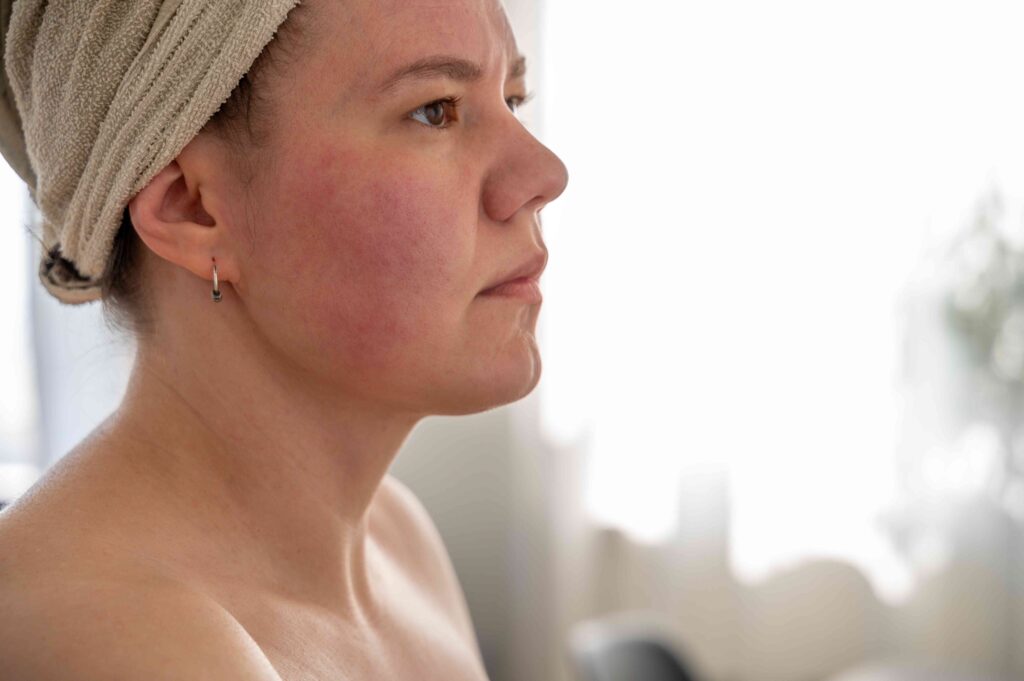:max_bytes(150000):strip_icc():format(jpeg)/Health-GettyImages-2157240146-c9c52f6caefe4cde9c8ca9b5977df588.jpg)
Skin flushing is a common reaction that causes the skin to redden or darken. Flushing, also called blushing, happens due to increased blood flow to the reddened area.
Flushing most often occurs on the face, neck, or upper torso. Depending on its cause, skin flushing may come and go or be constant. You might notice that it has certain triggers or may seem to occur randomly.
While skin flushing is often not a cause for concern, it can sometimes be a sign of an underlying health condition, such as a tumor. Getting a diagnosis for the cause of your flushing can help you get the proper treatment. Your primary healthcare provider is a great place to start for a diagnosis.
Skin flushing may look and feel different depending on its cause. Skin flushing generally looks like reddening of the skin. For people with darker skin, it may look like a dark brown or violet color. Skin flushing usually occurs on the face, neck, ears, arms, or chest.
Along with this visible change, you may feel warmth in the affected area. The area may also itch, burn, develop hives, or thicken over time.
Skin flushing occurs when blood vessels widen and fill with more blood, causing the skin to change color. There are several possible causes of this increased blood flow. Skin flushing is often triggered by nervous system signals or substances acting directly on the blood vessels.
Flushing related to the nervous system may have causes such as fever, heightened emotions or nervousness, and hormone changes. These conditions often cause increased sweating as well, so these flushing episodes are sometimes called wet flushes.
Flushing related to substances that act on the blood vessels may have causes such as rosacea and certain medications or foods. Sweating does not typically occur in these situations, so these episodes are sometimes called dry flushes.
1. Increased Body Temperature
Flushing can be a sign that your body temperature is elevated. Body temperature can rise for reasons like:
- Fever due to an infection
- Overheating from exercise
- Direct heat exposure
- Consumption of hot beverages
When your temperature rises past a certain point, you will likely sweat along with flushing. Sweating is your body’s way of cooling you off and lowering your temperature.
2. Heightened Emotions
Another common cause of skin flushing is an intense emotional response. When you feel a strong emotion, such as embarrassment, excitement, anxiety, or anger, your nervous system releases stress hormones that can cause blood vessels to widen. This leads to increased blood flow near the skin’s surface, resulting in flushing.
Emotional flushing seems to be more common in women. It often happens along with other signs of stress responses, such as dry mouth, confusion, and changes in heart rhythm.
3. Menopause
During menopause (the permanent end of menstruation), levels of the hormone estrogen drop, leading to the common menopause symptom of hot flashes. Over half of women over age 45 experience hot flashes.
Hot flashes can cause intense feelings of heat in the body, skin flushing, and sweating. Each hot flash typically lasts 3-5 minutes and may happen many times throughout the day. Hot flashes often lead to anxiety and trouble sleeping.
4. Rosacea
Rosacea is a chronic skin condition causing redness and flushing primarily on the face. It usually appears on the nose and cheeks but can spread to other parts of the face and the ears, scalp, neck, chest, or back.
Rosacea can lead to visible blood vessels, red bumps, thickened skin, and irritation. Rosacea also often affects the eyes, causing dryness, burning, crustiness, or discoloration around the eyes.
Rosacea can have triggers similar to temporary flushing—like stress, spicy foods, or extreme temperatures—but it lasts longer and might worsen over time.
5. Medications
Many medications can cause skin flushing as a side effect. Vasodilators, medications used to treat high blood pressure and other heart conditions, most commonly cause flushing. Other medications that can lead to flushing include:
- Niacin (nicotinic acid), a type of B vitamin
- Beta-blockers, which can help with irregular heart rate (arrhythmia) and other cardiovascular issues
- Angiotensin-converting enzyme (ACE) inhibitors, which help manage high blood pressure (hypertension)
- Steroid drugs, such as glucocorticoids
- Hormone therapy drugs
- Reglan (metoclopramide), which is used to treat gastroesophageal reflux disease (GERD)
- Chemotherapy drugs
- Opiates
Many other medications can also lead to flushing when combined with alcohol.
6. Spicy Foods or Alcohol
Certain ingredients or additives in food can trigger the blood vessels to widen, causing flushing. Capsaicin in spicy foods is the dietary substance most commonly associated with flushing. Sulfites and nitrates—both frequently used to preserve foods—can also lead to flushing.
Alcohol can trigger flushing, partly because certain types of alcohol, especially red wine, contain high levels of sulfites. Acetaldehyde, the chemical compound that breaks down alcohol, can also increase blood flow and cause flushing.
Most people can break down acetaldehyde and pass it out of their body. However, certain people, notably those of Asian descent, do not produce enough of the enzyme needed to do so. When they drink alcohol, acetaldehyde may build up in their body and cause extreme flushing.
Less Common Causes
While the causes listed above are not usually worrying, skin flushing can also indicate a serious health condition that requires treatment. Health conditions that can cause flushing include:
- Neurologic disorders: Conditions that cause lesions (wounds) in parts of the nervous system can cause flushing. Examples include cluster headaches, epilepsy, and multiple sclerosis (MS).
- Carcinoid syndrome: This syndrome causes tumors to grow along the gastrointestinal tract and lungs. The tumors release hormones, like serotonin, that cause blood vessels to widen. As a result, about 90% of people with this syndrome have skin flushing.
- Pheochromocytoma: This is a tumor that grows from the cells of the adrenal glands. It’s usually not cancerous, but it makes the adrenal gland produce too many hormones, which can lead to skin flushing.
- Medullary thyroid cancer: In this type of rare cancer, a tumor grows from a certain type of cells in the thyroid. The tumor cells release hormones that lead to skin flushing.
- Pancreatic tumors: Certain rare tumors can grow in the pancreas and cause blood vessels to widen. About a fifth of people with these tumors have skin flushing. Their skin also may thicken or turn a bluish color.
- Mastocytosis: In this condition, the body makes too many mast cells, a type of immune cell that triggers inflammation. Mast cells then build up in tissues and release chemicals that can lead to flushing.
Most causes of skin flushing are temporary and have no cause for concern. It is natural for the body to trigger processes that lead to flushing when you are feeling stressed, embarrassed, or overheated.
If your flushing won’t go away or comes back frequently for no apparent reason, contact a healthcare provider so they can investigate its cause. Flushing that happens alongside other symptoms (e.g., diarrhea or abdominal pain, skin changes, headache) may indicate an underlying health condition is the cause.
The best treatment for skin flushing will depend on its cause. In temporary situations, such as high emotion or fever, the flush will pass when the triggering situation ends. You can then avoid these triggers whenever possible.
If an underlying health condition is causing flushing, you may need to treat the condition. Some underlying conditions are not dangerous, but their symptoms are distressing.
Some people find the flushing and other symptoms of rosacea to be embarrassing, while hot flashes stemming from menopause can significantly lower quality of life. Your healthcare provider may recommend a medication or topical treatment to ease symptoms in these cases.
More serious conditions that cause flushing, like cancer or a neurological disorder, need treatment specific to the condition. Even benign (non-cancerous) tumors can negatively affect your body, so do your best to get an accurate diagnosis.
While some causes of skin flushing are hard to avoid, you can do a few things to help prevent it. Here are some tips:
- Keep a symptom log: Note when your flushing happens and what you ate, drank, or did right before you noticed it. Note any other symptoms that occur with the flushing.
- Avoid known triggers: If certain foods, drinks, or environmental factors cause your flushing, avoid them when possible to prevent the reaction.
- Cool down: Carrying a small fan, using a cool compress, or splashing cold water on your face can help manage heat-related flushing when it occurs.
- Stay hydrated: Drinking plenty of water can help regulate body temperature and prevent flushing.
- Wear sunscreen: Sun exposure can trigger flushing in people with sensitive skin. Using sunscreen daily and wearing hats or protective clothing can help protect the skin.
- Choose skincare products carefully: For those with sensitive skin or conditions like rosacea, gentle, fragrance-free skincare products can help avoid further irritation.
- Manage stress: Practicing relaxation techniques like deep breathing, meditation, or progressive muscle relaxation may help reduce stress-related flushing.
Skin flushing is the reddening or darkening of skin. It is a common symptom and can happen for various reasons. While flushing is often harmless, repeated or intense flushing can be uncomfortable and may mean there is an underlying health issue.
If you have skin flushing that seems unrelated to having strong emotions, being overheated, eating spicy foods, or drinking alcohol, discuss it with a healthcare provider.













